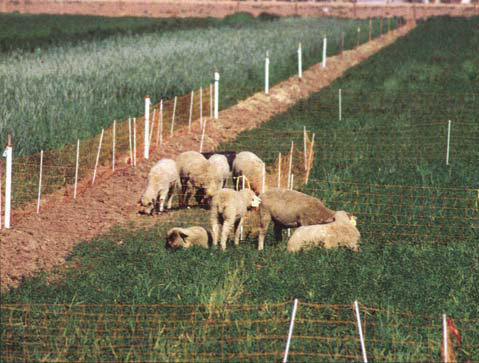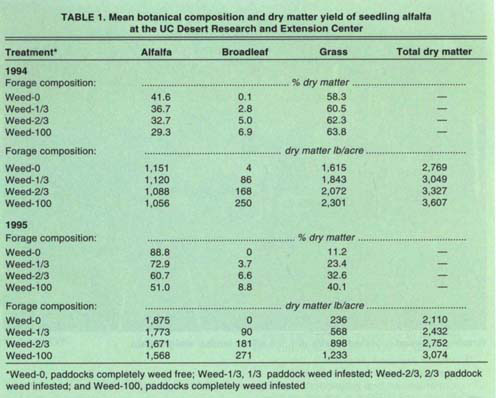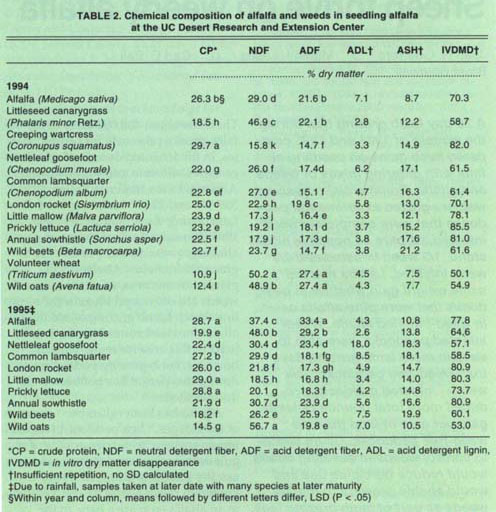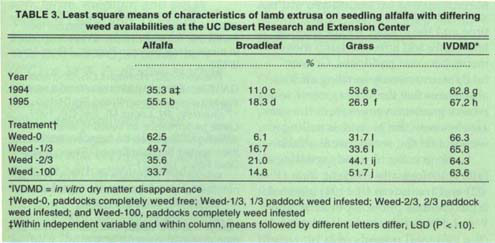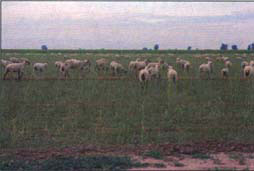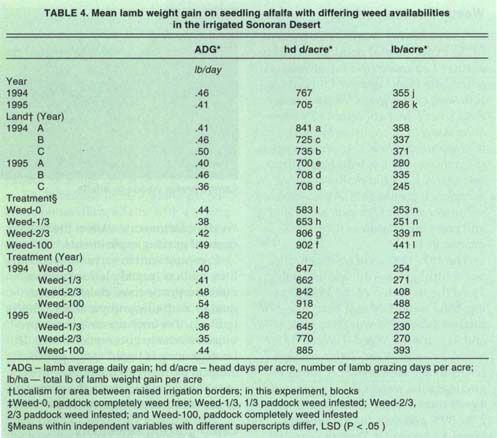All Issues
Sheep thrive on weedy alfalfa
Publication Information
California Agriculture 53(5):29-32. https://doi.org/10.3733/ca.v053n05p29
Published September 01, 1999
PDF | Citation | Permissions
Abstract
A 28-day iamb grazing trial during the winters of 1994 and 1995 compared lamb gains on seedling alfalfa with differing mixes of weeds and aifalfa. Commercial crossbred wethers grazed experimental paddocks that were completely weed infested, as pure as possible alfalfa stand, 1/3 weed infested and 2/3 weed infested. Lambs had the same weight gain whether in paddocks that were pure alfalfa or in weed-infested alfalfa. Weed-infested paddocks were able to sustain more lamb grazing days than weed-free paddocks. The weed- infested paddocks produced more total pounds of lamb gain per acre of land than the weed-free paddocks. Using lambs to control weeds in seedling alfalfa would reduce herbicide use and would enable growers to market weeds as part of lamb grazing fees.
Full text
There are about 400,000 acres of alfalfa, grown primarily for nearby dairies, in the irrigated deserts of southeastern California and southwestern Arizona. In the Imperial Valley, 339,806 and 225,000 lambs grazed alfalfa during the winter in 1994 and 1995, respectively. Lamb owners pay alfalfa growers a head-per-day fee to graze alfalfa fields. Alfalfa is fall-planted in this area, so winter annual weeds are often a problem in the seedling stand. Lamb grazing of seedling alfalfa for weed control has been practiced in this area for many winters; however, lamb grazing performance during this period has not been well documented.
Alfalfa has been called the “queen of the forages.” In a paddock of mixed forage species, as the percentage of legumes increases, animal performance usually increases also. Lambs are known to relish alfalfa forage. Weeds in an alfalfa crop are a bane to the grower, so much effort is expended to control weeds. Some weed species in alfalfa hay may create “off flavors” in milk. Other weeds are toxic to livestock. Conversely, many weed species, at times, can provide excellent quality forage.
Prior lamb grazing research at the UC Desert Research and Extension Center (UCDREC) in the Imperial Valley demonstrated that lambs are an effective weed-control measure in seedling alfalfa and that subsequent alfalfa hay yields were not affected by grazing (Bell et al. 1996) In these stands, lambs preferred to eat the weeds before they consumed the alfalfa. This research, however, did not evaluate lamb weight gains on weed-infested seedling alfalfa. Therefore we evaluated lamb gain and total gain per acre on seedling alfalfa with various weed availabilities during the winter grazing season in the irrigated deserts of southeastern California.
Four alfalfa/weed treatments
We conducted a lamb grazing trial in 1994 and 1995 at UCDREC, 7 miles east of El Centro. In 1994 and 1995, we used 68 and 78 wethers, respectively, of similar origins and from the same local grazier. The 5-to-7-month-old lambs were 25% to 50% Suffolk and 75% to 50% indistinguishable white-faced breeds. The initial mean weight of the lambs was 86 pounds. All lambs had been treated with anthelmintics and vaccinated against Clostridium perfringens Types C and D.
Experimental paddocks were seeded with 30 pounds per acre of ‘CUF-101’ alfalfa on Oct. 10, 1993, and on Oct. 5, 1994, and flood irrigated. Three 66-foot-wide lands (a localism for the area between irrigation borders) were used as blocks in this trial. We randomly allocated two 0.1-acre paddocks within each land to each of four weed control treatments: (1) entire paddock sprayed with herbicides in an attempt to remove weeds and have as pure an alfalfa stand as possible (Weed-0); (2) 2/3 of the paddock sprayed to have 1/3 of the paddock weed infested (Weed-1/3); (3) 1/3 of the paddock sprayed to have 2/3 of the paddock weed infested (Weed-2/3); and (4) paddock not sprayed to have the entire paddock weed infested (Weed-100). On Nov. 29, 1993, and Nov. 22, 1994, we applied the following herbicide mixture: imazethapyr at 0.094 lb ai/acre; 2,4-DB amine at 1 lb ai/acre; ammonium nitrate at 2.2 lb/acre and crop oil 1% v/v. The herbicide mixture was applied with a tractor-mounted sprayer in 30 gallons of water per acre.
TABLE 1. Mean botanical composition and dry matter yield of seedling alfalfa at the UC Desert Research and Extension Center
TABLE 2. Chemical composition of alfalfa and weeds in seedling alfalfa at the UC Desert Research and Extension Center
To determine lamb grazing preferences on seedling alfalfa with varying amounts of weeds, we esophageally fistulated four wethers with a common grazing experience of the other experimental lambs. Esophageal canulas removed, fistulated lambs grazed for 30 minutes each morning. To maximize the amount of esophageal extrusa, fistulated lambs were fasted overnight prior to grazing. After the morning sampling period, the fistulated lambs grazed an adjacent seedling alfalfa paddock for the remainder of the day. Each day of the 28-day grazing trial, the four fistulated lambs were placed in a single block, one lamb per treatment. Fistulated lambs were rotated to a new block and to a different treatment daily. After the morning collection period, lamb esophageal extrusa was washed, filtered in cheese cloth and frozen for subsequent chemical analyses.
By experimental design, the forage dry matter (DM) per paddock varied in our experimental paddocks. To maintain a constant grazing pressure on all the paddocks, we used the put-and-take grazing method. To use this method, additional “grazer” lambs were placed in or removed from experimental paddocks based on our estimates of forage biomass. We used four constant “tester” lambs per 0.1-acre experimental paddock per grazing session. Each day, the total number of lambs – testers plus grazers – per experimental paddock was noted to calculate cumulative head days per acre (hd d/acre). At the initiation of grazing, to reduce the effects of rumen fill on liveweight, tester lambs were weighed after a 16-hour overnight fast.
Grazing initiated on Jan. 25, 1994, and on Jan. 30, 1995. Lambs grazed experimental paddocks for 14 days and then grazed another 14 days on the same treatment in the same block. After 28 days of grazing, tester lambs were fasted for 16 hours and weighed. Tester liveweights were used to calculate average daily gain (ADG, as pounds per head day). Total pounds of lamb gain per acre were calculated as tester ADG multiplied by hd d/acre.
On the day prior to first grazing, to estimate forage biomass and biomass composition, the forage in eight randomly allocated 2.69-foot2 quadrats in each experimental paddock was clipped. Forage and extrusa samples were separated into alfalfa and individual weed fractions and dried for 72 hours at 122°F in a forced-air oven. Forage and extrusa samples were subjected to the following chemical analyses: DM, Kjeldahl nitrogen, ash, neutral detergent fiber (NDF), acid detergent fiber (ADF) and acid detergent lignin (ADL). We used the fungal cellulase method to estimate percentage in vitro dry matter disappearance (IVDMD) of the extrusa and the individual forage species.
We used analyses of variance to evaluate the experimental data. Year, land within year, treatment and treatment x year were the independent variables that affected the dependent variables: ADG, hd d/acre and total lamb gain per acre. Year, individual iamb within year, treatment and treatment withim year were the independent variables that affected the lamb extrusa dependent variables: percent alfalfa, percent broadleaf, percent grasses and IVDMD.
TABLE 3. Least square means of characteristics of lamb extrusa on seedling alfalfa with differing weed availabilities at the UC Desert Research and Extension Center
Weedy seedling alfalfa
The following weeds were present in the experimental paddocks: prickly lettuce (Lactuca sertiok L.), annual sowthistle (Sonchus asper L., Hill), littleseed canarygrass (Phalaris minor Retz.), nettleleaf goosefoot (Chenopo-dium murale L.) common lambsquarter (Chenopodium album L.), london rocket (Sisymbrium L.), wild beets (Beta macrocarpa L.), little mallow (Malva parviflora L.), wild oats (Avena fatua L.), volunteer wheat (Triticum aestevum L.) and creeping wartcress (Coronopus squamatus L.).
The 1993 herbicide treatment did not control grasses adequately (table 1). At the initiation of the 1994 grazing, total weed DM as a percentage of total paddock DM was 58%, 63%, 67% and 71% for the Weed-0, Weed-1/3, Weed-2/3 and Weed-100 treatments, respectively. At the start of the 1995 grazing, total weed DM as a percentage of total paddock DM was 11%, 27%, 39% and 49% for the Weed-0, Weed-1/3, Weed-2/3 and Weed-100 treatments, respectively.
Greater than normal precipitation in November 1993 affected our herbicide treatment. Imazethapyr stunted the grasses but did not kill them. The grasses later regrew. Our herbicide treatments, however, controlled the broadleaf weeds. On the same paddock, annual pasture yields often vary twofold to fourfold. Forage DM yields differed each year of our grazing trial. Annual pasture yield variability is normal in grazing trials, and must be accounted for in the design of the experiment. Uncontrollable and random weather factors often affect the outcome of grazing experiments.
Creeping wartcress, london rocket, little mallow, prickly lettuce and annual sowthistle have chemical feed quality attributes comparable to alfalfa (table 2). The cool-season grasses provided relatively good-quality feed. If lamb grazing is timed to the physiological maturity of the weeds, many of the weed species have the potential of providing high-quality feed.
Lamb grazing selectivity
In weedy seedling alfalfa in this experiment, lambs selected broadleaf weeds and grasses (table 3) in greater proportion than their relative availabilities in the experimental paddocks (table 1). Prior lamb grazing trials at UCDREC on weedy seedling alfalfa demonstrated that lambs initially consumed weeds and as the weed availability decreased, the lambs started to consume alfalfa. Year affected the percentage of alfalfa (P = .09), broadleaf weeds (P = .04) and grass (P < .01) in lamb esophageal extrusa. Lamb diets contained 53.6% and 26.9% grasses in 1994 and 1995, respectively (table 3). Alfalfa consumption (P = .02) by individual lambs within year differed, but not for broadleaf weeds (P = .22) or grasses (P = .34). Lambs within the same grazing group commonly had quite different diet selection patterns. Treatment did not affect the percentage of alfalfa (P = .49) or broadleaf weeds (P = .49) in lamb esophageal extrusa, but did affect the percentage of grasses (P = .08) (table 3). When we moved lambs to Weed-0 paddocks, we noticed that they actively searched out the surviving cool-season grasses before they ate alfalfa.
TABLE 4. Mean lamb weight gain on seedling alfalfa with differing weed availabilities in the irrigated Sonoran Desert
Year affected in vitro dry matter disappearance (IVDMD) of lamb esophageal extrusa (P < .01); however, individual lambs within year (P = .56) had no effect. In 1994 and 1995 overall treatments, the IVDMD were 62.8% and 67.2%, respectively (table 3). The yearly IVDMD varied as the yearly botanical composition varied (table 1), the high content of grasses in 1994 decreasing the overall JVDMD. Treatment had no effect (P = .31) on IVDMD. Whether the lambs consumed weeds or alfalfa, they consumed a similarly digestible diet.
Lamb gains
Neither year (P = .19), land (P = .33) nor treatment (P = .23) affected lamb average daily gain (ADG) (table 4). Yearly ADG was not affected by treatments, even though annual forage dry matter production was different (table 1) and mean annual percentage IVDMD was different (table 3). Grazing weedy seedling alfalfa paddocks in comparison to relatively weed-free paddocks had no effect on lamb ADG. Lamb ADG in other UCDREC studies had been affected by yearly forage attributes. The importance of multipleyear grazing studies and the inclusion of the variable “year” as a random variable in the experimental design cannot be overestimated.
Lamb production per acre
We expected varying amounts of forage biomass in the treatment paddocks. Year did not affect (P = .17) hd d/acre; however, lands (P = .01) and treatment (P < .01) did affect hd d/acre. By experimental design, we expected to place a greater number of lambs on the weedier plots. Greater hd d/acre on weedy seedling alfalfa means that a given number of lambs will graze a given paddock for a greater period of time and the grazier will be making less costly and stressful lamb movements between paddocks. Greater hd d/acre on weedy seedling alfalfa also means that the alfalfa grower will receive greater revenues from the grazier because the grower is selling weeds as if the weeds were alfalfa.
Lamb grazing of weedy seedling alfalfa is biologically efficient. Year (P = .02) and treatment (P < .01) affected lamb yield as pounds per acre. The Weed-100 paddocks had greater (P < .05) total pounds of lamb weight gain per acre than any of the herbicide-treated paddocks. Past UCDREC lamb grazing studies have demonstrated that lambs efficiently control weeds and that after lamb grazing, subsequent alfalfa hay yields were similar on grazed and herbicide-treated plots.
Neither lamb nor alfalfa performance were decreased by grazing weedy seedling alfalfa. Lamb ADG on weedy seedling alfalfa and on herbicide-treated alfalfa was the same. Lamb grazing of weedy seedling alfalfa contributes to sustainable agricultural production practices. Since the Weed-100 and Weed-2/3 paddocks in creased head days per acre, the grazier would benefit economically by reducing labor costs by using a specific field for a longer period before having to move lambs to another field, an activity that causes stress and weight loss in the lambs. The grower would benefit economically by reducing herbicide costs and by being able to market weeds as if the weeds were alfalfa.



